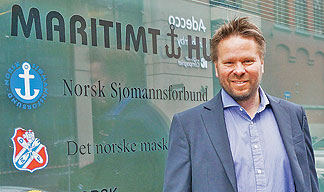
UK seafarers have been hit hard by the downturn in the offshore oil industry, but how have their North Sea neighbours been faring? ANDREW DRAPER met maritime unions in Norway to find out…
Like the UK, the Norwegian offshore service sector has experienced a sharp decline in activity in recent years, with resulting lay-ups of ships and lay-offs of seafarers. Shipowners have driven down costs relentlessly, and the unions are battling on a slippery slope to maintain national working conditions and pay levels on the Norwegian continental shelf.
But increasingly, flag of convenience (FoC) vessels with cheaper labour are appearing in Norwegian waters, as are vessels under the Norwegian international ship register NIS. While they're not supposed to engage in cabotage along the key Norwegian coastal route, it is happening – much to the consternation of the unions. The coastal trade has been traditionally carried out by vessels in the domestic ship register NOR, which is for ships engaged in cabotage.
Terje Hernes Pettersen, attorney at law for the Norwegian Seafarers' Union, told the Telegraph that the union sought support from the country's mayors for its campaign against social dumping two years ago.
The mayors – representing cities and towns along the coast of Norway, where the bulk of the population lives – were taken aback.'We asked the mayors for their support that ships operating outside their windows should be under Norwegian conditions. They were really surprised. They took it for granted that we had Norwegian conditions,' Mr Pettersen recalls.
The union met the mayors, from a range of political parties, and all but two declared their support for the demand for Norwegian working conditions.
'Along the coastline, NOR was to be the register with most ships. NOR, according to the last survey two years ago, was down to 20% of the total. So it means most ships operating between Norwegian ports have another flag, and not with Norwegian conditions,' Mr Pettersen points out.
For a passenger ship to be registered in NIS, it must call at two foreign ports, he adds. But, earlier this year, the Hurtigruten ferry company registered one of its newest ships under the NIS, and the vessel made a voyage calling at nine Norwegian ports before it went to Svalbard. The crew was mainly Asian.
'We don't want NIS ships along the Norwegian coast,' Mr Pettersen says. The union is concerned at developments affecting the ferry service that connects towns along the coast. It has been run by Hurtigruten since 1893, but – in a competitive tender – the offshore operator Havila Shipping won a 10-year contract to operate four of the 11 ships along the coast, between Bergen in the south and Kirkenes in the far north, starting in 2021. Hurtigruten won the rest of the tender.
There was much union concern that Havila might seek to register vessels under a flag of convenience, with a potential loss of hundreds of Norwegian jobs. However, the company announced in September that it was planning to operate all its vessels under NOR – which came as a relief to the unions. It and Hurtigruten will depart Bergen on different days.
Vessels under the NIS register are not supposed to engage in cabotage around Norway – but it is happening


Norwegian Seafarers' Union president Johnny Hansen says this ensures Norwegian wages and conditions for seafarers. 'The Norwegian Seafarers' Union wishes to be a constructive cooperation partner in the future process,' he adds.
The downturn in oil prices hit Norway hard, as it is a massive producer. The offshore sector is now recovering on the back of higher oil prices, with some labour shortages reported. But around 100 offshore vessels are still laid up, down from the 160 or so that were put out of action at the depth of the downturn, according to the union.
'Naturally, jobs were lost due to the market situation,' says Mr Pettersen. 'But what our members don't accept is when there still is a contract but the shipowner chooses to switch from NOR to an FoC register, so – according to Norwegian law – it can then dismiss the Norwegian seafarers and replace them with foreigners. And there have been many examples of that.'
Inadequate data means the union does not know exactly how many seafarers have been replaced, but a third of union representatives reported that Norwegian crews had been replaced by cheaper foreign ones.
'NOR ships have Norwegian wage levels,' Mr Pettersen notes. 'For FoC ships, there are international wage levels that are half the Norwegian level.'
It's not just the pay that's different, he stresses. 'Under our collective bargaining agreement, we work one on one – four weeks on and four weeks off at home – but, on international contracts, it is six to seven months on continental ships and half the salary. So it's not equal competition.'
In its annual report on the state of the industry, the Norwegian Shipowners' Association pointed out that light was on the horizon, with increased profitability forecast and the bottom of the market having been reached – not least for the offshore sector.
Despite continuing tough times, 35% of offshore sector companies expected greater profitability in 2018 up from 15% a year earlier. It foresaw total lay-ups to fall to 110 vessels by year end, from 148 in 2017. This is based on increased activity, and more scrapping and sale of vessels. The end-of-year scenario is expected to match that of autumn 2016.
The owners' report stated that 3,100 jobs were temporarily or permanently lost in 2017 because of the downturn, while 2,800 were taken on – a net loss of 300 jobs. Of the jobs lost, 1,800 Norwegians were laid off in the offshore service sector. Much of that shedding will be reversed by the end of 2018, the report predicted.
The owners warn, however, that employment of Norwegian seafarers relies heavily on government subsidies – and if the government were to reduce them significantly, 80% of Norwegian shipowners would replace national seafarers with foreign crews.
Controversially, the government has just approved plans to extend the option for NIS vessels to ply Color Line's ferry routes to and from Germany, in place of NOR-flagged ships. There is still much political toing and froing over this, but if it does go ahead, Color Line will be able to save substantial costs by replacing up to 700 Norwegians with cheaper foreign crews. There is also a fear among unions in neighbouring countries that this 'race to the bottom' could spread to other Nordic ferry operators.
'Greed has apparently no limit when a company – which every year receives about £30m in subsidies from the government and had a profit of £50m last year – is asking for political support to replace Norwegian seafarers with cheap foreign labour,' Mr Hansen reflects.
Tags
